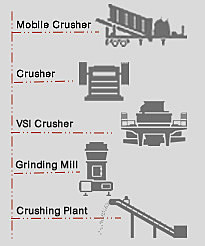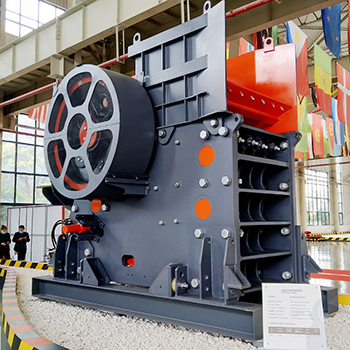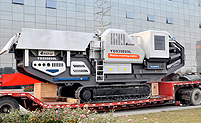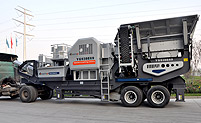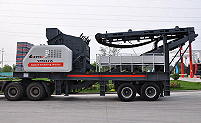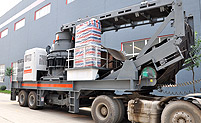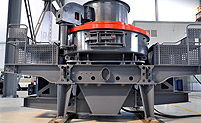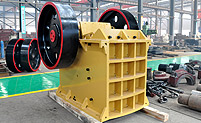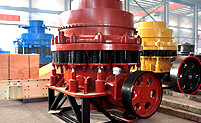Ballast crusher
Track ballast forms the trackbed upon which railway sleepers (UK) or railroad ties (US) are laid. It is packed between, below, and around the ties. It is used to facilitate drainage of water, to distribute the load from the railroad ties, and also to keep down vegetation that might interfere with the track structure. This also serves to hold the track in place as the trains roll by. It is typically made of crushed stone, although ballast has sometimes consisted of other, less suitable materials. The term "ballast" comes from a nautical term for the stones used to stabilize a ship.
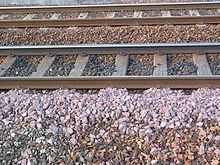
Material properties
A good ballast should be strong, hard-wearing, stable, drainable, easy to clean, workable, resistant to deformation, easily available, and reasonably cheap to purchase. Early railway engineers did not understand the importance of quality track ballast; they would use cheap and easily-available materials such as ashes, chalk, clay, earth, and even cinders from locomotive fireboxes. It was soon clear that good-quality ballast made of rock was necessary if there was to be a good foundation and adequate drainage.
Good quality track ballast is made of crushed natural rock with particles between 28 mm and 50 mm in diameter; a high proportion of particles finer than this will reduce its drainage properties, and a high proportion of larger particles result in the load on the ties being distributed improperly.Angular stones are preferable to naturally rounded ones, as angular stones interlock with each other, inhibiting track movement. Soft materials such as limestone are not particularly suitable, as they tend to degrade under load when wet, causing deterioration of the line; granite, although expensive, is one of the best materials in this regard.
In the early days of railroads in the United States, much material for ballast came from rock found in the local area. In the Midwest, for example, much use was made of quartzite, while states in the southeast, such as Florida, made use of limestone. One specific type of quartzite used in the Midwest earned the name "Pink Lady" due to its color; in other areas, the ballast can be a mix of light and dark colors called "Salt and Pepper".
Construction
The thickness of a layer of track ballast depends on the size and spacing of the ties, the amount of traffic expected on the line, and various other factors. Track ballast should never be laid down less than 150 mm (6 inches) thick; high-speed railway lines may require ballast up to half a metre (20 inches) thick. An insufficient depth of ballast overloads the underlying soil; in the worst cases, this can cause the track to sink. If the ballast is less than 300 mm (12 inches) thick, this can lead to vibrations, which can damage nearby structures (though increasing the depth beyond this has no measurable effect).
Track ballast typically sits on a layer of sub-ballast; the latter is typically made of small crushed stones. It gives a solid support for the top ballast, and seals out water from the underlying ground. Sometimes, an elastic mat is placed under the ballast layer as well; this can allow for significant reductions in vibration.
It is essential for ballast to be piled as high as the ties, and for a substantial "shoulder" to be placed at their ends; the latter being especially important, since this ballast shoulder is, for the most part, the only thing restraining lateral movement of the track. The ballast shoulder should be at least 150 mm (6 inches) wide under any circumstances, and may be as large as 450 mm (18 inches).
Maintenance
New track ballast is placed at the Boxmeer railway station, The Netherlands.
A ballast regulator shaping newly placed ballast
Ballast tamping machine as used in railroad track maintenance -- Dade City, Florida
If ballast is badly fouled, the clogging will reduce its ability to drain properly; this, in turn, causes more debris to be sucked up from the sub-ballast, causing more fouling. Therefore, keeping the ballast clean is essential. It is not always necessary to replace the ballast if it is fouled, nor must all the ballast be removed if it is to be cleaned. Removing and cleaning the ballast from the shoulder is often sufficient, if shoulder ballast is removed to the correct depth. While this job was historically done by manual labour, this process is now, like many other railway maintenance tasks, a mechanised one, with a chain of specially-designed railroad cars handling the task. One wagon cuts the ballast and passes it via a conveyor belt to a cleaning machine, then the cleaning wagon washes the ballast, and deposits the dirt and ballast into other wagons for disposal and re-use, respectively. Such machines can clean up to two kilometres of ballast in an hour.
Cleaning, however, can only be done a certain number of times before the ballast is damaged to the point that it cannot be re-used; furthermore, track ballast that is completely fouled can not be corrected by shoulder cleaning. In such cases, it is necessary to replace the ballast altogether. One method of "replacing" ballast, if necessity demands, is to simply dump fresh ballast on the track, jack the whole track on top of it, and then tamp it down;alternatively, the ballast underneath the track can be removed with an undercutter, which does not require removing or lifting the track.
Regular inspection of the ballast shoulder is important; as noted earlier, the lateral stability of the track depends upon the shoulder. The shoulder acquires some amount of stability over time, being compacted by traffic; maintenance tasks such as replacing ties, tamping, and ballast cleaning can upset this stability. After performing these tasks, it is necessary for either trains to run at reduced speed on the repaired routes, or to employ machinery to compact the shoulder again.
If the trackbed becomes uneven, it is necessary to pack ballast underneath sunk ties to level the track out again. This is, in the mechanized age, usually done by a ballast tamping machine. A more recent, and probably better, technique is to lift the rails and ties, and to force stones, smaller than the track ballast particles and all of the same size, into the void. This has the advantage of not disturbing the well-compacted ballast on the trackbed, as tamping is likely to do. This technique is called pneumatic ballast injection (PBI; or, less formally, "stoneblowing"). However, this technique is not as effective with fresh ballast, as the smaller stones tend to move down between the larger pieces of ballast.
PrevPage: Asbestos crusher
Next Page: Coal mining equipment

